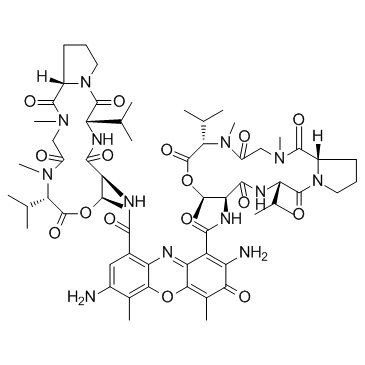7-Aminoactinomycin D (7-AAD) (Synonyms: 7-AAD, NSC 239759) |
| Katalog-Nr.GC33577 |
7-Aminoactinomycin D (7-AAD) (7-AAD), ein fluoreszierender DNA-Farbstoff, ist ein potenter RNA-Polymerase-Inhibitor.
Products are for research use only. Not for human use. We do not sell to patients.

Cas No.: 7240-37-1
Sample solution is provided at 25 µL, 10mM.
7-Aminoactinomycin D (7-AAD) is a fluorescent DNA dye that is commonly used to detect or exclude non-viable cells in flow cytometry analysis because 7-AAD is usually excluded by living cells[1][ 2]. 7-AAD exhibits excitation spectra at 488, 546, and 578 nm and an emission spectrum at 650 nm [3]. Since 7-AAD is detected in the far-red range of the spectrum, it has minimal spectral overlap with commonly used probes and thus can be used in combination with probes such as FITC [1] [3]. 7-AAD has been used to assess apoptosis and cell-mediated cytotoxicity and to stain DNA in cells fixed and permeabilized by various methods [1] [2] [4].
7-AAD is a fluorescent derivative of actinomycin D that selectively binds to the GC region of DNA [5]. Taking advantage of the permeability of the cell membrane and the fact that the fluorescence intensity of 7-AAD is lower in early apoptotic cells and higher in late apoptotic and dead cells, it can be performed in fixed/permeabilized cells by flow cytometry. cycle analysis. Low concentrations (0.5-5μg/ml) of 7-AAD are often used to stain and exclude dead cells in flow cytometry; higher concentrations (10-20μg/ml) of 7-AAD are used to distinguish live cells (7-AAD negative ), apoptotic cells (7-AAD dim bright) and dead cells (7-AAD)[5].
References:
[1].Schmid, I., Uittenbogaart, C.H., Keld, B., et al.A rapid method for measuring apoptosis and dual-color immunofluorescence by single laser flow cytometryJ. Immunol. Methods170(2)145-157(1994)
[2].Coder, D.M.Assessment of cell viabilityCurr. Protoc. Cytom.Suppl. 15(1997)
[3].Stokke, T., Holte, H., and Steen, H.B.In vitro and in vivo activation of B-lymphocytes: A flow cytometric study of chromatin structure employing 7-aminoactinomycin DCancer Res.48(23)6708-6714(1988)
[4].Lecoeur, H., Février, M., Garcia, S., et al.A novel flow cytometric assay for quantitation and multiparametric characterization of cell-mediated cytotoxicityJ. Immunol. Methods253(1-2)177-187(2001)
[5].Nadine C L Zembruski, et al. 7-Aminoactinomycin D for apoptosis staining in flow cytometry. 2012 Oct 1;429(1):79-81. doi: 10.1016/j.ab.2012.07.005. Epub 2012 Jul 14.
Average Rating: 5 (Based on Reviews and 12 reference(s) in Google Scholar.)
GLPBIO products are for RESEARCH USE ONLY. Please make sure your review or question is research based.
Required fields are marked with *




